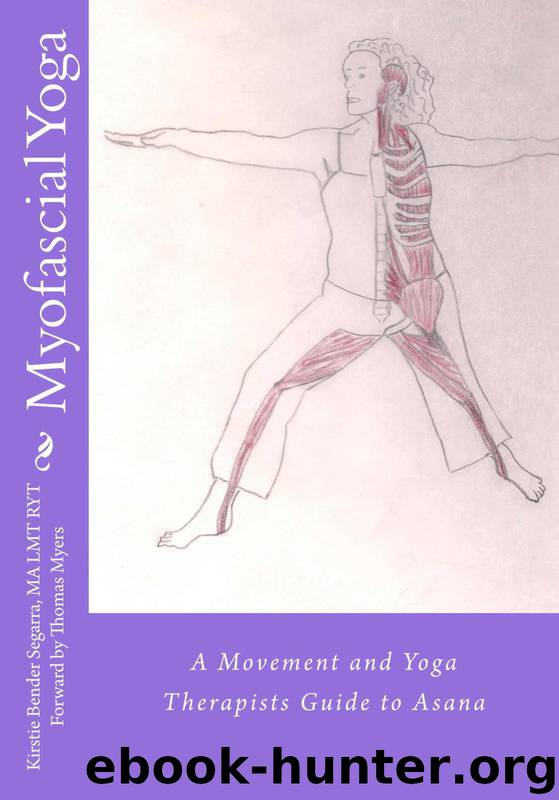Myofascial Yoga: A movement and yoga therapists guide to asana by Segarra Kirstie Bender

Author:Segarra, Kirstie Bender [Segarra, Kirstie Bender]
Language: eng
Format: epub
Publisher: Balinese Traditional Massage LLC
Published: 2013-08-10T21:00:00+00:00
Why does somatic stretching work?
Schleip, in his article “Fascial mechanoreceptors and their potential role in deep tissue manipulation”, refers to four types of mechanoreceptors in fascia. The Golgi tendon (Type 1b) reflex arc and organs involved in muscle contraction are noted by Cottingham to respond to slow stretch. However, Schleip states it is “too bad—it is not a simple reflex!” As later research shows, that passive stretching of a myofascial tissue does not stimulate the Golgi tendon organs. Stimulation happens when the muscle fibers are actively contracted. For example, when a client takes seated forward fold and their toes and legs are relaxed they are in a passive mode, thus the Golgi tendon organs are not stimulated. However, if the client engages the back line and brings the “toes to the nose” while pressing through the heels they will stimulate the Golgi tendon organs.
The Golgi receptors are involved with balance!
Dietz (1992) states that “In order to handle the extreme antigravity balancing challenges as a biped, our central nervous system can reset the Golgi tendon receptors and related reflex arcs so they function as very delicate antigravity receptors.”[9] To translate, our Golgi tendons give us the neurofeedback we need for balance—often a key in every asana.
What about the other mechanoreceptors?
There are four other types of mechanoreceptors. Three are classified as Type II and the fourth, Interstitial, is a Type III and IV found almost everywhere inside bone with the highest density in the periosteum. The Interstitial mechanoreceptors respond to rapid and sustained pressure changes. Of the Type II mechanoreceptors, the first are the Pacini (Type II), which respond to rapid changes in pressure and to vibrations. Next are the Paciniform (Type II) corpuscles which perform a similar function as the Pacini with an increased sensitivity. Last are the Ruffini (Type II), which respond to sustained pressure. “Ruffini endings will also be activated by slow and deep ‘melting quality’ soft tissue techniques.”[10]
These mechanoreceptors are found in all types of connective tissue—the fascia. The slower deeper techniques have an affect on lowering the sympathetic nervous system inviting the overall feeling of relaxation. It makes sense! Our largest sensory organ is our muscle with the related fascia. The fasciae are an interconnected web, like a school of fish or a flock of birds. When one fish shifts, as in a change of a singular motor unit, the rest follow.
With the discovery of the Ruffini mechanoreceptors, we have our explanation of how we are able to shift patterns, like a school of fish changing direction, in our fascial net. In fact, I have found that a combination of “slow and deep” targeting of the Ruffini mechanoreceptors, muscle contractions or engagement for Golgi tendon and sound vibrations for the Pacini and Paciniform mechanoreceptors work wonders.
Our role as teachers and therapists is to guide the client through the subtle awareness of engaging a line. When the client is activating their muscles through the myofascial meridians they may realign the firing of the muscles in a healthy pattern.
Download
This site does not store any files on its server. We only index and link to content provided by other sites. Please contact the content providers to delete copyright contents if any and email us, we'll remove relevant links or contents immediately.
Periodization Training for Sports by Tudor Bompa(8171)
Bodyweight Strength Training by Jay Cardiello(7844)
Born to Run: by Christopher McDougall(7065)
Inner Engineering: A Yogi's Guide to Joy by Sadhguru(6728)
Asking the Right Questions: A Guide to Critical Thinking by M. Neil Browne & Stuart M. Keeley(5650)
The Fat Loss Plan by Joe Wicks(4850)
Bodyweight Strength Training Anatomy by Bret Contreras(4614)
Yoga Anatomy by Kaminoff Leslie(4308)
Dynamic Alignment Through Imagery by Eric Franklin(4118)
Science and Development of Muscle Hypertrophy by Brad Schoenfeld(4089)
ACSM's Complete Guide to Fitness & Health by ACSM(3989)
Exercise Technique Manual for Resistance Training by National Strength & Conditioning Association(3957)
The Four-Pack Revolution by Chael Sonnen & Ryan Parsons(3932)
Bodyweight Strength Training: 12 Weeks to Build Muscle and Burn Fat by Jay Cardiello(3919)
The Ultimate Bodybuilding Cookbook by Kendall Lou Schmidt(3886)
Yoga Anatomy by Leslie Kaminoff & Amy Matthews(3864)
American Kingpin by Nick Bilton(3759)
Nutrition for Sport, Exercise, and Health by Spano Marie & Kruskall Laura & Thomas D. Travis(3715)
Yoga Therapy by Mark Stephens(3704)
